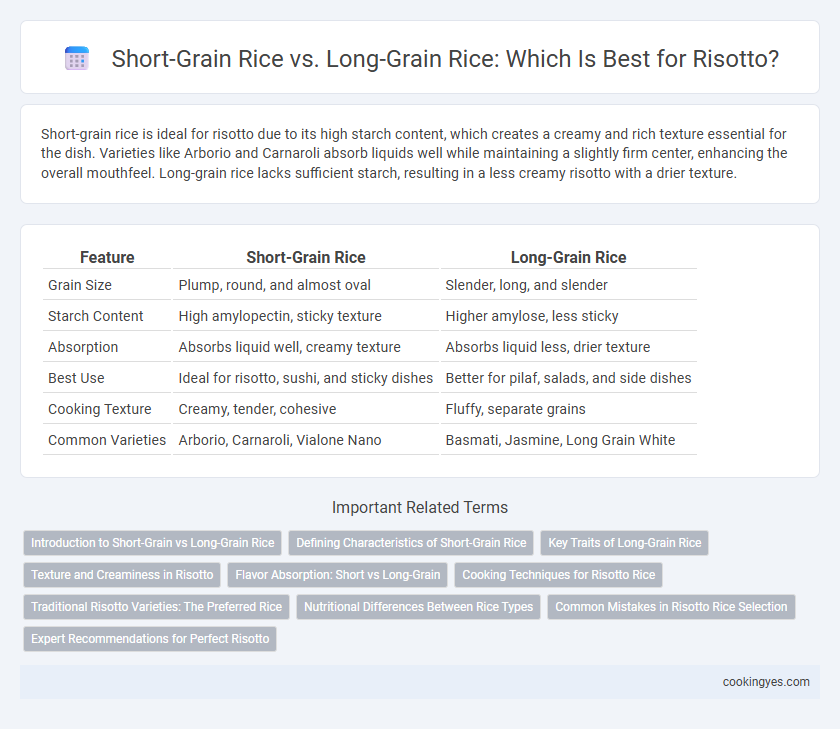Short-grain rice is ideal for risotto due to its high starch content, which creates a creamy and rich texture essential for the dish. Varieties like Arborio and Carnaroli absorb liquids well while maintaining a slightly firm center, enhancing the overall mouthfeel. Long-grain rice lacks sufficient starch, resulting in a less creamy risotto with a drier texture.
Table of Comparison
| Feature | Short-Grain Rice | Long-Grain Rice |
|---|---|---|
| Grain Size | Plump, round, and almost oval | Slender, long, and slender |
| Starch Content | High amylopectin, sticky texture | Higher amylose, less sticky |
| Absorption | Absorbs liquid well, creamy texture | Absorbs liquid less, drier texture |
| Best Use | Ideal for risotto, sushi, and sticky dishes | Better for pilaf, salads, and side dishes |
| Cooking Texture | Creamy, tender, cohesive | Fluffy, separate grains |
| Common Varieties | Arborio, Carnaroli, Vialone Nano | Basmati, Jasmine, Long Grain White |
Introduction to Short-Grain vs Long-Grain Rice
Short-grain rice has a higher starch content and a shorter, plumper shape, making it ideal for creamy dishes like risotto due to its ability to absorb liquids and release starch. Long-grain rice remains fluffy and separate when cooked, with lower amylopectin levels, which results in a less creamy texture unsuitable for traditional risotto. Choosing short-grain varieties such as Arborio or Carnaroli ensures the desired creamy consistency and texture essential for authentic risotto recipes.
Defining Characteristics of Short-Grain Rice
Short-grain rice, essential for authentic risotto, is characterized by its high starch content and plump, round grains that release creamy starch during cooking. This variety absorbs flavors and liquids well, resulting in the signature creamy texture of risotto. Unlike long-grain rice, which remains separate and fluffy, short-grain rice's stickiness and moisture retention make it ideal for achieving the desired consistency in traditional Italian risotto dishes.
Key Traits of Long-Grain Rice
Long-grain rice is characterized by its slender, elongated grains that remain separate and fluffy when cooked, making it less suitable for creamy dishes like risotto. Its lower starch content compared to short-grain rice results in a drier texture, which prevents the signature smooth and velvety consistency essential in authentic risotto. Cultivars such as basmati and jasmine represent common long-grain varieties, prized for their fragrant aroma and firm bite but not ideal for risotto's creamy texture.
Texture and Creaminess in Risotto
Short-grain rice varieties such as Arborio and Carnaroli are preferred for risotto due to their high starch content, which creates a creamy and velvety texture essential for this dish. Long-grain rice tends to be less starchy and firmer, resulting in a drier, less cohesive risotto that lacks the signature creaminess. The unique amylopectin levels in short-grain rice grains ensure optimal absorption of broth while releasing starch gradually for a rich, smooth consistency.
Flavor Absorption: Short vs Long-Grain
Short-grain rice, such as Arborio, excels in flavor absorption due to its higher starch content, which creates the creamy texture essential for authentic risotto. Long-grain rice lacks this starch density, resulting in grains that remain separate and less infused with the cooking broth's flavors. Choosing short-grain rice enhances both the dish's creaminess and its ability to fully absorb savory ingredients.
Cooking Techniques for Risotto Rice
Short-grain rice, particularly Arborio, is ideal for risotto due to its high amylopectin starch content, which creates a creamy texture essential to traditional risotto. Cooking techniques emphasize gradual liquid absorption through slow, steady stirring to release starch and develop the signature creamy consistency. Long-grain rice lacks sufficient starch and tends to remain separate and fluffy, making it less suitable for achieving the classic risotto texture.
Traditional Risotto Varieties: The Preferred Rice
Arborio and Carnaroli are the traditional short-grain rice varieties preferred for risotto due to their high starch content, which creates the creamy texture essential to the dish. Short-grain rice varieties absorb liquids well, releasing amylopectin starch that thickens the risotto, while long-grain rice, such as Basmati or Jasmine, lacks this starch content and remains separate when cooked. Carnaroli is often favored among chefs for its ability to maintain shape during slow cooking, striking a balance between creaminess and texture in authentic risotto preparation.
Nutritional Differences Between Rice Types
Short-grain rice, commonly used for risotto, contains higher starch content, resulting in a creamier texture and slightly increased calorie count compared to long-grain rice. Long-grain rice has a lower glycemic index and less amylopectin, making it less sticky and offering a slightly higher fiber content. Nutritionally, short-grain rice provides more energy-dense carbohydrates, while long-grain rice supports better blood sugar regulation.
Common Mistakes in Risotto Rice Selection
Using long-grain rice for risotto often results in a dish lacking the creamy texture characteristic of traditional risotto, as it releases less starch compared to short-grain varieties like Arborio or Carnaroli. Common mistakes include choosing non-starchy rice that doesn't absorb flavors well or overcooking grains that break down instead of yielding a velvety consistency. Selecting high-starch short-grain rice ensures the ideal balance of creaminess and bite essential for authentic risotto preparation.
Expert Recommendations for Perfect Risotto
Short-grain rice varieties like Arborio, Carnaroli, and Vialone Nano are expert-recommended for risotto due to their high starch content, which creates the dish's signature creamy texture. Long-grain rice lacks this starch concentration, resulting in a less cohesive and buttery risotto consistency. Chefs consistently emphasize short-grain rice to achieve the ideal balance of creaminess and al dente bite in authentic risotto preparation.
Short-grain rice vs Long-grain rice for risotto Infographic

 cookingyes.com
cookingyes.com